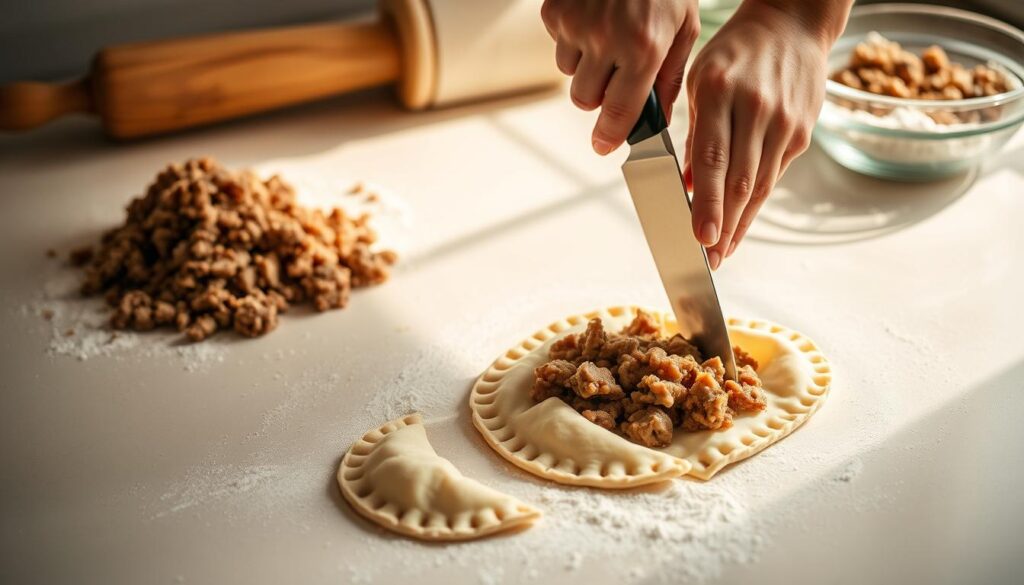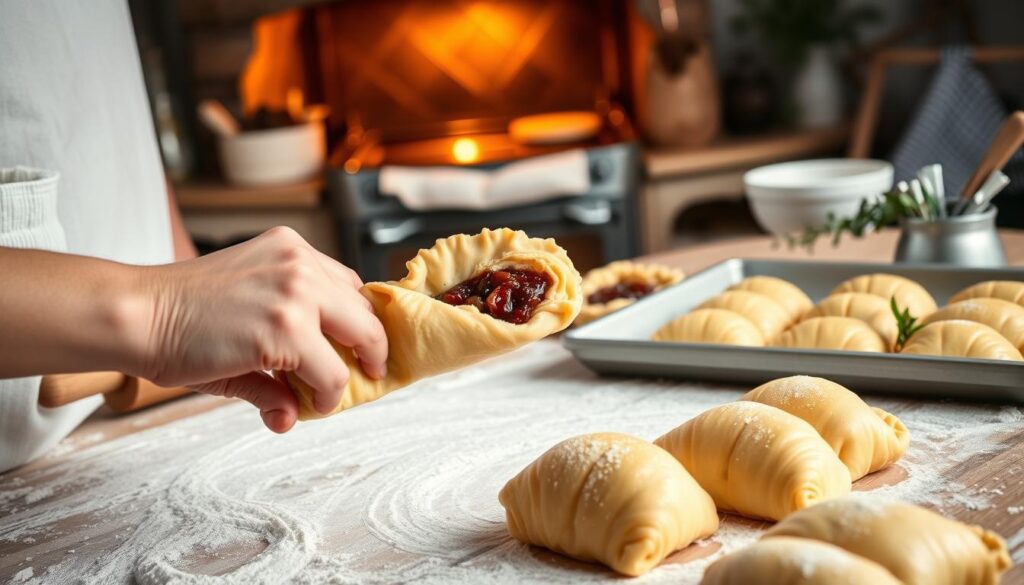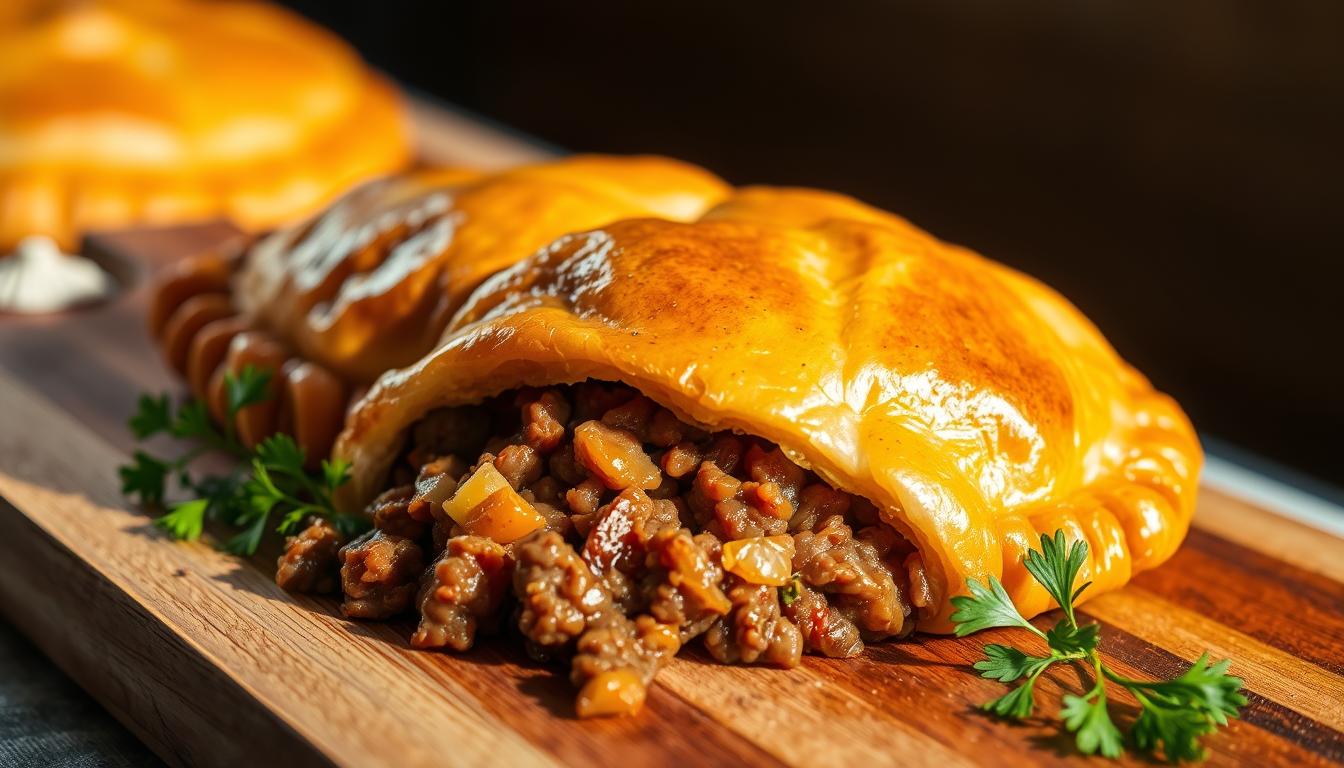Mince Meat Pasties There’s something truly special about a perfectly made pasty. Originating from Cornwall, these hand-held pies have traveled the world , becoming a beloved treat for many. Whether you call it a “pah-stee” or a “pay-stee,” its buttery crust and hearty fillings have made it a timeless favorite1.
But crafting the perfect pastry isn’t always easy. From choosing the right ingredients to mastering the dough, there are common pitfalls that can turn your efforts into a kitchen disaster. This article is here to guide you through the process, helping you avoid mistakes and achieve a consistently delicious result.
We’ll explore the importance of proper ingredient selection, handling the dough with care, and perfecting your baking techniques. Whether you’re a seasoned cook or a beginner, these tips will elevate your pasty-making skills. Let’s dive in and create something extraordinary.
Key Takeaways
- Learn how to avoid common mistakes when making pasties.
- Discover the importance of ingredient selection and dough handling.
- Understand the role of proper baking techniques for a perfect finish.
- Gain insights into the rich history and tradition of Cornish pasties.
- Get actionable tips to improve your pasty-making skills.
Introduction to Mince Meat Pasties
The journey of the pasty is steeped in history and tradition. Originating in Cornwall, these hand-held pies were more than just a meal—they were a lifeline for miners. Packed with hearty fillings like beef, potato, and onion, they provided sustenance during long hours underground2.
Exploring the History and Tradition
Cornish miners relied on pasties for their practicality. The thick crust served as a handle, keeping their hands clean while eating. Some even say the pastry was marked with initials to identify the owner3.
As Cornish miners traveled the world, they brought their beloved pasty with them. This led to its global popularity, with variations emerging in places like Michigan and Australia4.
“The pasty is more than food—it’s a piece of Cornish heritage.”
Why These Hand Pies Continue to Impress
Today, the pasty remains a favorite for its versatility. While traditional fillings like beef and potato are still popular, modern recipes experiment with unique ingredients. From spicy chorizo to vegetarian options, there’s a pasty for every palate.
Its flaky crust and hearty fillings make it a comforting meal, whether enjoyed fresh from the oven or on the go. The debate over pronunciation—pah-stee or pay-stee—only adds to its charm.
Key Ingredients and Preparation Techniques
Crafting the perfect hand-held pie starts with the right ingredients and techniques. From selecting fresh vegetables to mastering the dough, every step plays a crucial role in achieving a flaky crust and a flavorful filling. Let’s break down the essentials.
Selecting Quality Meat and Vegetables
Begin with high-quality ground beef, ensuring it’s fresh and lean for the best texture. Pair it with fresh vegetables like carrot, potato, and onion. Caramelizing these vegetables adds depth to the filling, creating a robust flavor foundation5.
For seasoning, a mix of salt, pepper, and garlic enhances the natural flavors. Adding a splash of Worcestershire sauce introduces a tangy umami note, balancing the richness of the beef.
Mastering the Dough and Filling Assembly
The dough is the backbone of your pie. Combine flour, butter, and a pinch of salt to create a crumbly mixture. Add cold water gradually until the dough comes together. Chill it for at least 30 minutes to ensure easy rolling and a flaky texture.
When assembling, roll the dough into circles and evenly distribute the filling. A balanced mixture of beef, carrot, and potato ensures every bite is flavorful. Seal the edges tightly to prevent leaks during baking.

Tips on Preheating and Seasoning
Always preheat your oven to the recommended temperature before baking. This ensures even cooking and a golden crust. For seasoning, taste the filling mixture before assembly. Adjust with additional salt, pepper, or a hint of garlic as needed.
Remember, seasoning is a multi-step process. Adding a touch of acid, like lemon juice, can brighten the flavors5. Finish with a brush of egg wash for a glossy, golden top.
| Step | Key Action | Tip |
|---|---|---|
| 1 | Select Ingredients | Choose fresh, high-quality items for the best flavor. |
| 2 | Prepare Dough | Chill the dough for easier handling and a flaky texture. |
| 3 | Assemble Filling | Balance beef, carrot, and potato for a cohesive mixture. |
| 4 | Season and Bake | Preheat the oven and adjust seasoning before baking. |
By focusing on quality ingredients and precise techniques, you’ll create a hand-held pie that’s both delicious and satisfying. Every step, from selecting the beef to perfecting the dough, contributes to the final result.
Avoiding Common Mistakes with Mince Meat Pasties
Even experienced cooks can make mistakes when preparing pasties. From undercooked fillings to a soggy crust, small errors can ruin your hard work. By understanding these pitfalls, you can ensure your hand-held pie turns out perfectly every time.
Preventing Under or Overcooked Fillings
One of the most common issues is unevenly cooked fillings. To avoid this, start by browning your ground beef and vegetables on the stovetop before baking. This ensures they’re partially cooked, reducing the risk of undercooked centers6.
Monitor your baking time closely. Overcooking can dry out the filling, while undercooking leaves it raw. A golden brown crust is a good indicator of doneness. Use a timer to track the bake minute accurately.
Ensuring a Flaky and Robust Crust
A soggy crust is another frequent problem. To prevent this, handle your dough with care. Chill it before rolling to maintain its structure. Avoid overfilling the pie, as excess moisture can seep into the crust6.
Seal the edges tightly to keep the filling inside. Use an egg wash to create a barrier against moisture. Preheating your oven is crucial for a flaky texture. A properly preheated oven ensures even baking and a crisp finish.
Balancing your filling is key. Too much liquid can make the crust soggy. Adjust the consistency by adding ingredients like potato or reducing sauces. Season with salt, pepper, and garlic to enhance flavor without excess moisture.
By following these tips, you can avoid common mistakes and create a pasty that’s both delicious and visually appealing. Small tweaks in technique make a big difference in the final result.
Baking and Finishing Techniques
Achieving the perfect bake for your hand-held pies requires precision and attention to detail. From setting the right oven temperature to mastering the art of crimping, every step matters. Let’s explore the techniques that will elevate your baking game.

Proper Oven Settings and Baking Times
Start by preheating your oven to 375°F. This ensures even heat distribution, which is crucial for a golden brown crust. Bake your pies for 25 to 30 minutes, or until the edges are crisp and the top is golden7.
Set a timer to monitor the baking time accurately. Overbaking can dry out the filling, while underbaking leaves the dough raw. Adjust the time slightly based on your oven’s behavior for the best results.
Crimping, Sealing, and Venting for Perfection
Properly sealing the edges of your pie prevents leaks during baking. Use a fork or your fingers to crimp the dough firmly. This not only seals the filling but also adds a decorative touch.
Create small slits on the top of the pie to allow steam to escape. This prevents the crust from becoming soggy and ensures even baking. Brush the top with an egg wash for a glossy, golden finish8.
| Step | Key Action | Tip |
|---|---|---|
| 1 | Preheat Oven | Set to 375°F for even heat distribution. |
| 2 | Bake Time | 25-30 minutes for a golden brown crust. |
| 3 | Crimp Edges | Use a fork or fingers for a secure seal. |
| 4 | Vent Top | Cut small slits to release steam. |
| 5 | Egg Wash | Brush for a glossy, golden finish. |
Handling your pies immediately after baking is essential. Let them cool on a wire rack to maintain their crispness. This also prevents the bottom from becoming soggy due to trapped steam.
Experiment with slight adjustments in baking time based on your oven’s performance. These small tweaks can make a big difference in achieving the perfect bake.
Conclusion
Mastering the art of creating these hand-held delights is both rewarding and satisfying. By focusing on quality ingredients and precise techniques, you can achieve a flaky crust and a flavorful filling every time. Remember to chill your dough before rolling, and preheat your oven for even baking9.
Avoid common mistakes like overfilling or undercooking by browning your filling beforehand and monitoring your baking time closely. The blend of tradition and modern updates makes this recipe versatile and timeless. Whether you stick to classic flavors or experiment with new ones, attention to detail is key.
Now that you’ve learned the essentials, it’s time to put them into practice. Revisit the detailed instructions, gather your ingredients, and enjoy the process. With patience and care, you’ll create a pasty that’s both delicious and memorable. Happy baking!

